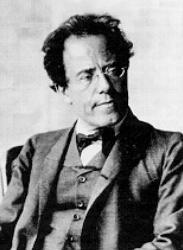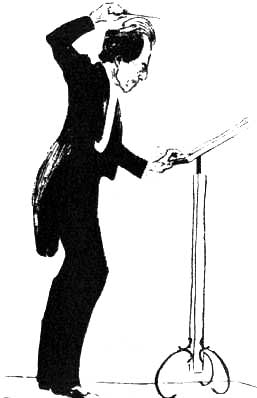Gustav Mahler - Biography
Gustav Mahler Biography
Gustav Mahler (July 7, 1860 – May 18, 1911) was best known in his own time as one of the leading Austrian conductors of his day, but is now remembered as an important composer linking the late 19th century with the modern musical period, particularly for his vast symphonies and his symphonic song cycle, Das Lied von der Erde. His third symphony, at approximately 95 minutes, is one of the longest symphonies ever performed, and is currently the longest of all symphonies in the general symphonic repertoire.
| Contents |
Biography
Mahler was born into a Jewish family in Kaliste, Bohemia. His parents moved to Jihlava, Moravia in the first year of his life, where Mahler spent his childhood. In 1875 he was admitted to the Vienna Conservatoire where he studied piano under Julius Epstein. Subsequently, Mahler attended lectures given by Anton Bruckner at Vienna University. His first major attempt at composition came with Das Klagende Lied which he entered in a competition as an opera (he later turned it into a cantata). However, he was unsuccessful, and turned his attention to conducting. After his first conducting job at Bad Hall, he took posts at a succession of increasingly larger opera houses; Ljubljana in 1881, Olomouc in 1882, Kassel in 1884, Prague in 1885, Leipzig in 1886 and Budapest in 1891. He then secured his first long-term post at the Hamburg Opera in 1891, where he stayed until 1897. While there, he took his summer vacations at Steinbach-am-Attersee, during which he concentrated on composition. He completed his Symphony No. 1 and the Lieder aus 'Des Knaben Wunderhorn' in this period.
In 1897, Mahler converted from Judaism to Roman Catholicism in order to secure a post as artistic director of the prestigious Vienna Court Opera (Jews were virtually prohibited from holding the post at that time). For the next ten years he stayed at Vienna, where he was noted as a great perfectionist. He ran the Opera for nine months of the year, spending the other three composing, mainly at Maiernigg, where he had a small house on the Wörthersee. There he composed his symphonies 4 through 8, as well as the 5 Rückert-Lieder, the Kindertotenlieder and his last song from texts in Des Knaben Wunderhorn entitled 'Der Tambourg'sell'. He married Alma Schindler (1879–1964) in 1902. They had two daughters, Anna (1904–1988) who later became a sculptor, and Maria Anna (1902–1907) who died of scarlet fever or diphtheria in 1907. In the same year he discovered he had heart disease (infective endocarditis), and he lost his job at Vienna, hounded out by a largely anti-semitic press after trying to promote his own music, which was not well received on the whole. While his 4th Symphony was well received by some, not until the performance of his Symphony No. 8 in 1910 did Mahler have a true public success with his music. The pieces he wrote after that were not performed in his lifetime.
Mahler was coming under increasingly virulent anti-semitic attacks — in 1907 these became almost unbearable — when Mahler received an offer to conduct Metropolitan Opera in New York. He conducted a season there in 1908, only to be set aside in favor of Arturo Toscanini. Mahler returned to New York the next year to become conductor of the newly formed New York Philharmonic Orchestra. Around this time, he completed Das Lied von der Erde, and the Symphony No. 9, which turned out to be his last completed work. During his last visit to America in February 1911, he fell seriously ill and was taken back to Vienna at his request.
He died there from a streptococcus infection on May 18, 1911 in Vienna, Austro-Hungarian Empire (now Austria), leaving his tenth symphony incomplete. His last word was: 'Mozart'. He is buried in Vienna, in the Grinzinger Cemetery.
The music of Gustav Mahler
Gustav Mahler began from the German tradition of music, which was rooted in the music of Johann Sebastian Bach and the 'Vienna School' of Haydn, Mozart, Beethoven and Schubert, and incorporated the Romantic generation of composers, such as Schumann and Mendelssohn. However, the decisive influence on his work was Richard Wagner who, he said, after Beethoven was the only composer to truly have 'development' (see Sonata Form) in his music.
Mahler combined the ideas of Romanticism — including having titles for symphonies, or combinations of movements (see Program music), and the use of song melodies in symphonic works — with the huge orchestral resources which the development of symphony orchestras had made possible. The result was that he extended, and finally broke, the understanding of symphonic form, as he searched for ways to expand his musical universe. He stated that a symphony should be an entire world. Mahler, as a result, met with difficulties in presenting his works, and would continually revise the details of orchestration until he was satisfied with the effect.
Mahler's symphonies are generally divided into three periods. The first, dominated by his reading of the Wunderhorn poems, and incorporating characteristic melodies from his song settings of them, includes the first four numbered symphonies. His second period, including the next three symphonies, focuses on increasing severity of expression, including the 'Tragic' symphony, whose hammer blows shocked Viennese audiences, and inspired other composers. His last period is marked by increasing polyphony and includes his Eighth, Ninth, and unfinished Tenth Symphonies, as well as the song cycle-symphony of Das Lied von Der Erde.
Mahler was obsessed by Beethoven's legacy, and, on one hand, was terrified of writing a ninth numbered symphony, while on the other he declared that all of his symphonies were 'ninths', meaning symphonies which had the same impact and scale as the famous D minor. Few composers can be said to have freely intermixed their work and their life so completely. In the manuscript of the 10th Symphony, there are notations to his wife Alma — who was, at the time, having an affair with Walter Gropius, the man she would later marry — as well as other autobiographical references. He was deeply spiritual, and was described as 'always telephoning God' and describing his music in terms of Nature, in a way that demands a capital N in English.
This resulted in a view of his music as 'hyper-emotional' — even extreme — for a long time after his death. Although it is certainly true that he restlessly searched for ways of extending symphonic expression, he was also an ardent craftsman, which shows both in his meticulous working methods and careful planning of works and in his studies of previous composers.
Mahler's legacy
Mahler's pivotal role in what followed made him, in some respects, the Haydn of modern music. His compositions had a tremendous impact on Schoenberg, Webern, and Berg immediately, as well as the conductors Bruno Walter and Otto Klemperer — both of whom worked with Mahler and were helped in their careers by him, and would take his music to America, where it would influence Hollywood film composition. He was also an influence on Erich Korngold and on his friend and contemporary Richard Strauss as well as the early symphonies of Havergal Brian. His innovations include melodies with far reaching implications for harmony, expressive use of combinations of instruments, in both the large and small scale, larger percussion sections, as well as combining voice and chorus in the symphony form, and more extreme voice leading in his counterpoint.
Because he was not only a composer, but an innovative conductor, his methods and techniques survive to the present. He was famous for saying 'tradition is sloppiness,' and requiring extensive rehearsals of works. This led to tensions between Mahler and his orchestras, even as it produced finer performances than had been previously possible.
Mahler's difficulties in getting his works accepted led him to say 'my time will come,' and in the mid 20th century, it did. Advocated by both those who had known him, and by a generation of conductors including the American composer-conductor Leonard Bernstein, an audience hungry for the next wave of musical exploration who seemed to be 'large enough' for the times embraced his works. Soon, complete Mahler symphony cycles were recorded and his works became the pinnacle test for many conductors.
In the late 20th century, new musicological methods allowed the extensive editing of his scores, and various attempts to complete the 10th Symphony, as well as improved versions of his other symphonies. Currently Pierre Boulez, Riccardo Chailly, Claudio Abbado, Bernard Haitink, Seiji Ozawa, Sir Simon Rattle, Michael Tilson Thomas, Zubin Mehta, Markus Stenz and Benjamin Zander are among the most well known of many Mahler interpreters, and his music continues to attract interest.
List of works
Symphonies
- Symphony No. 1 (D major), Titan (1884–1888)
- Symphony No. 2 (C minor, ends in Eb major), Resurrection (1888–1894)
- Symphony No. 3 (D minor) (1895–1896)
- Symphony No. 4 (G major, ends in E major), (1899–1901)
- Symphony No. 5 (C# minor, ends in D major), (1901–1902)
- Symphony No. 6 (A minor), Tragic (1903–1904)
- Symphony No. 7 (E minor, ends in C major), Song of the Night (1904–1905) (Subtitle not by Mahler)
- Symphony No. 8 (Eb major), Symphony of a Thousand (1906) (Subtitle not by Mahler, and, in fact, strongly derided by him)
- Symphony No. 9 (D major, ends in Db major) (1909–1910)
- Symphony No. 10 (F# minor/major) (1910, incomplete, Adagio and Purgatorio prepared for performance by Ernst Krenek, completed versions by Deryck Cooke (1964, 1972, 1989), Clinton Carpenter (1966), Joseph Wheeler (1948 – 1965), Remo Mazzetti, Jr. (1989), Rudolf Barshai (2000), and Nicola Samale/Giuseppe Mazzucca (2002)). (Several prominent Mahler conductors refused to perform the complete 10th Symphony for various reasons, Bruno Walter and Leonard Bernstein most notably.)
Song cycles, song collections and other vocal works
- Das Klagende Lied 1880
- Drei Lieder (three songs for tenor and piano, 1880)
- Lieder und Gesänge aus der Jugendzeit (fourteen songs with piano accompaniment, 1880–1890)
- Lieder eines fahrenden Gesellen (for voice with piano or orchestral accompaniment, 1883–1885)
- Lieder aus 'Des Knaben Wunderhorn' (for voice and orchestra, 1892–1896, two others from 1899 and 1901)
- Rückert Lieder (for voice with piano or orchestral accompaniment, 1901–1902)
- Kindertotenlieder (for voice and orchestra, 1901–1904)
- Das Lied von der Erde, (1907–1909)
See also
This biography is published under the GNU Licence


